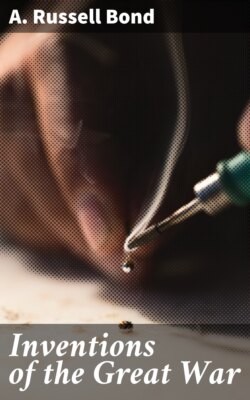Читать книгу Inventions of the Great War - A. Russell Bond - Страница 21
На сайте Литреса книга снята с продажи.
A GUN AS A GAS-ENGINE
ОглавлениеTable of Contents
Another big advance was made by a third American, Mr. John M. Browning, who is responsible for the Colt gun. It was not a kick that set Browning to thinking. He looked upon a gun as an engine of the same order as an automobile engine, and really the resemblance is very close. The barrel of the gun is the cylinder of the engine; the bullet is the piston; and for fuel gunpowder is used in place of gasolene. As in the automobile engine, the charge is fired by a spark; but in the case of the gun the spark is produced by a blow of the trigger upon a bit of fulminate of mercury in the end of the cartridge.
Courtesy of "Scientific American"
The Lewis Gun which produces its own cooling current
Courtesy of "Scientific American"
The Benèt-Mercié Gun operated by gas
Explosion is the same thing as burning. The only way that the explosion of gunpowder differs from the burning of a stick of wood is that the latter is very slow, while the former goes like a flash. In both cases the fuel turns into great volumes of gas. In the case of the gun the gas is formed almost instantly and in such quantity that it has to drive the bullet out of the barrel to make room for itself. In the cartridge that our army uses, only about a tenth of an ounce of smokeless powder is used, but this builds up so heavy a pressure of gas that the bullet is sent speeding out of the gun at a rate of half a mile a second. It travels so fast that it will plow through four feet of solid wood before coming to a stop.
(C) Committee on Public Information
Browning Machine Rifle, weight only 15 pounds
(C) Committee on Public Information
Browning Machine-Gun, weighing 34½ pounds
Now it occurred to Browning that it wouldn't really be stealing to take a little of that gas-power and use it to work the mechanism of his machine-gun. It was ever so little he wanted, and the bullet would never miss it. The danger was not that he might take too much. His problem was to take any power at all without getting more than his mechanism could stand. What he did was to bore a hole through the side of the gun-barrel. When the gun was fired, nothing happened until the bullet passed this hole; then some of the gas that was pushing the bullet before it would blow out through the hole. But this would be a very small amount indeed, for the instant that the bullet passed out of the barrel the gases would rush out after it, the pressure in the gun would drop, and the gas would stop blowing through the hole. With the bullet traveling at the rate of about half a mile in a second, imagine how short a space of time elapses after it passes the hole before it emerges from the muzzle, and what a small amount of gas can pass through the hole in that brief interval!
The gas that Browning got in this way he led into a second cylinder, fitted with a piston. This piston was given a shove, and that gave a lever a kick which set going the mechanism that extracted the empty cartridge-case, inserted a fresh cartridge, and fired it.
